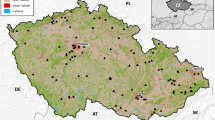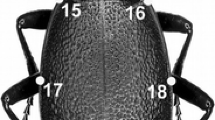Summary
We studied habitat and morphological relationships of nine species of birds comprising a groundforaging guild within four distinct locations in northern California. Although the nine species overlapped extensively in habitat use, we observed subtle differences among species in specific characteristics of the habitats they used. About 40% of all cases were classified to the correct species based on a discriminant analysis (DA) of habitats across all study areas. Classification success from DAs on habitats within study areas ranged from 42 to 66%. Morphologies of species differed to varying degrees as 91% of all cases were classified to correct species by a DA of morphological variables. This morphological separation suggested that each species used different modes of obtaining resources. We found only weak relationships between habitat use and morphology. Morphology predicted from 13.6 to 19.0% of the variation in habitat use within each study area and only 13.9% of the habitat variation across all study areas. Habitat predicted from 6.2 to 14.6% of the morphological variation within each study area and 6.9% across all study areas. We suggest that complimentary relationships of habitat and morphology enabled species within this guild to use unique sets of resources.
Similar content being viewed by others
References
Baldwin SP, Oberholser HC, Worley LG (1931) Measurements of birds. Clev Mus Nat Hist 2:1–144
Block WM (1985) Habitat and morphological relationships of a guild of ground-foraging birds in northern California. Thesis. Humboldt State University, Arcata, CA
Block WM, Brennan LA, Gutiérrez RJ (1986) Use of guilds and guild-indicator species for assessing habitat suitability. In: Verner J, Morrison ML, Rarlph CJ (eds) Wildlife 2000: modeling habitat relationships of terrestrial vertebrates. University of Wisconsin Press, Madison, pp 109–113
Brown JH (1984) On the relationship between abundance and distribution of species. Am Nat 124:255–279
Brown JH, Bowers MA (1985) Community organization in hummingbirds: relationships between morphology and ecology. Auk 102:251–269
Burnham KP, Anderson DR, Laake JL (1980) Estimation of density from line transect sampling of biological populations. Wildl Monogr 72:1–202
Canfield RH (1941) Application of the line interception method in sampling range vegetation. J For 39:388–394
Carrascal LM, Moreno E, Tellería JL (1990) Ecomorpological relationships in a group of insectivorous birds of temperate forests in winter. Holarctic Ecol 13:105–111
Cody ML (ed) (1985) Habitat selection in birds. Acdemic Press, Orlando, FL
Connell JH (1975) Some mechanisms producing structure in natural communities: a model and evidence from field experiments. In: Cody ML, Diamond JM (eds) Ecology and evolution of communities. Belnap Press, Cambridge MA, pp 460–490
Cooley WW, Lohnes RR (1971) Multivariate data analysis. Wiley, New York
Eckhardt RC (1979) The adaptive syndromes of two guilds of insectivorous birds in the Colorado Rocky Mountains. Ecol Monogr 49:129–149
Efron B (1982) The jackknife, the bootstrap, and other resampling plans. Society for Industrial and Applied Mathematics. Philadelphia, PA
Fretwell SD, Lucas HL (1970) On territorial behavior and other factors influencing habitat distribution in birds. I. Theoretical development. Acta Biotheor 19:16–36
Grant PR (1968) Bill size, body size, and the ecological adaptations of bird species to competitive situations on islands. Syst Zool 17:319–333
Green PE (1978) Analyzing multivariate data. Dryden Press, Hinsdale IL
Grinnell J (1917) The niche-relationships of the California thrasher. Auk 34:427–433
Gutiérrez RJ (1980) The comparative ecology of the mountain and California quails in the Carmel Valley, California. Living Bird 18:71–93
Hespenheide HA (1973) Ecological inferences from morphological data. Annu Rev Ecol Syst 4:213–229
Hildén O (1965) Habitat selection in birds: a review. Ann Zool Fenn 2:53–75
Holmes RT, Robinson SK (1981) Tree species preference of foraging insectivorous birds in a hardwood forest. Oecologia 48:31–35
James FC (1982) The ecological morphology of birds: a review. Ann Zool Fenn 19:265–275
Karr JR, James FC (1975) Ecomorphological configuration and convergent evolution. In: Cody ML, Diamond JM (eds) Ecology and evolution of communities. Belnap Press, Cambridge MA, pp 258–291
Kolasa J (1989) Ecological systems in hierarchical perspective: breaks in community structure and other consequences. Ecology 70:36–47
Laake JL, Burnham KP, Anderson DR (1979) User's manual for the program TRANSECT. Utah State University Press, Logan, UT
Lack D (1947) Darwin's finches. Cambridge, London, Great Britain
MacArthur RH (1958) Population ecology of some warblers of northeastern coniferous forests. Ecology 39:599–619
MacArthur RH, MacArthur JW (1961) On bird species diversity. Ecology 42:594–598
Miles DB, Ricklefs RE (1984) The correlation between ecology and morphology in deciduous forest passerine birds. Ecology 65:1629–1640
Miles DB, Ricklefs RE, Travis J (1987) Concordance of ecomorphological relationships in three assemblages of passerine birds. Am Nat 129:347–364
Morris RF, Cheshire WF, Miller CA, Mott DG (1958) The numerical response of avian and mammalian predators during a gradation of spruce budworm. Ecology 39:346–355
Noon BR (1981) The distribution of an avian guild along a temperate elevational gradient: the importance and expression of competition. Ecol Monogr 51:105–124
Pianka ER (1978) Evolutionary ecology. Harper's. New York
Pitelka FL (1951) Speciation and distribution in American jays of the genusAphelocoma. Univ Calif Berkeley Publ Zool 50:194–464
Rice WR (1989) Analyzing tables of statistical tests. Evolution 43:223–225
Ricklefs RE, Travis J (1980) A morphological approach to the study of avian community organization. Auk 97:321–338
Root RB (1967) The niche exploitation pattern of the blue-gray gnatcatcher. Ecol Monogr 37:317–350
Roth RR (1981) Vegetation as a determinant of avian ecology. In: Proc First Welder Wildlife Habitat Symposium, pp 162–174
Schluter D, Smith JNM (1986) Natural selection on beak and body size in the song sparrow. Evolution 40:221–231
Schoener TW (1965) The evolution of blll size differences among congeneric species of birds. Evolution 19:189–213
Schoener TW (1974) Resource partitioning in ecological communities. Science 185:27–39
Snedecor GW, Cochran WG (1980) Statistical methods. Seventh edition. Iowa State University, Ames
Sokal RR, Rohlf FJ (1969) Biometry. W. H. Freeman, San Francisco, CA
Svärdson G (1949) Competition and habitat selection in birds. Oikos 2:157–174
Tilman D (1989) Discussion: population dynamics and species interactions. In: Roughgarden J, May RM, Levin SA, (eds) Perspectives in ecological theory. Princeton University Press, New Jersey, pp 89–101
Tomoff CS (1974) Avian species diversity in desert scrub. Ecology 55:396–403
Willson MF (1974) Avian community organization and habitat structure. Ecology 55:1017–1029
Winkler H (1988) An examination of concepts and methods in ecomorphology. Proc Inter Ornith Congr 19:2246–2253
Author information
Authors and Affiliations
Rights and permissions
About this article
Cite this article
Block, W.M., Brennan, L.A. & Gutiérrez, R.J. Ecomorphological relationships of a guild of ground-foraging birds in northern California, USA. Oecologia 87, 449–458 (1991). https://doi.org/10.1007/BF00634605
Received:
Accepted:
Issue Date:
DOI: https://doi.org/10.1007/BF00634605




